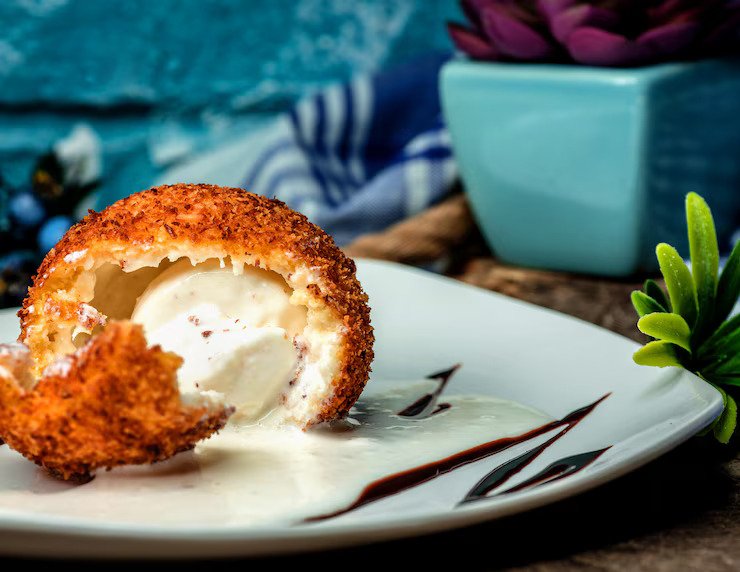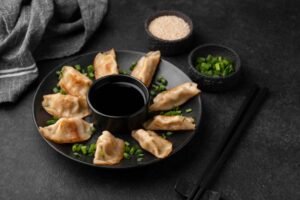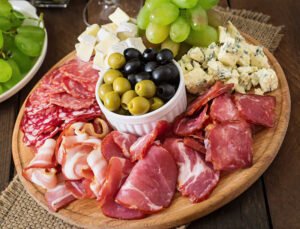The culinary landscape of Luxembourg, a small yet culturally rich country nestled between Belgium, France, and Germany, offers a fascinating array of dishes that reflect its unique blend of influences. Among its traditional foods, the quenelle stands out as a particularly intriguing delicacy. While often associated with French cuisine, quenelles in Luxembourg have their own distinct identity, deeply rooted in local culinary practices. This dish is not merely a food item but a reflection of the country’s complex historical and cultural tapestry.
A quenelle, in its essence, is a delicate dumpling made from a mixture of creamed fish, chicken, or meat, combined with breadcrumbs, eggs, and sometimes flour. The mixture is formed into an oval shape and poached until cooked through. In Luxembourg, this dish transcends its French origins and is commonly served in a variety of comforting scenarios. One might find it served in a hearty soup, where its subtle flavors blend seamlessly with rich broths, providing a warming dish perfect for the colder months. Alternatively, it is also presented alongside sauerkraut and potatoes, a combination that highlights the Germanic influences in Luxembourgish cuisine. This pairing allows the quenelle’s mildness to complement the tangy and robust flavors of the sauerkraut, creating a balanced and satisfying meal.
The preparation of quenelles in Luxembourg requires a meticulous approach, where texture and flavor are paramount. The consistency of the quenelle must be just right–firm enough to hold its shape yet soft enough to melt in the mouth. Achieving this balance involves precise measurements and techniques, often passed down through generations of cooks. The choice of ingredients is equally crucial, with fresh fish or high-quality meat forming the base of a truly exquisite quenelle. Each bite offers a glimpse into the culinary heritage of Luxembourg, where traditional methods meet local ingredients to produce a dish that is both familiar and distinctively unique.
For those exploring Luxembourg’s culinary offerings, indulging in a quenelle dish provides not only a taste of the region’s flavors but also an insight into its historical and cultural influences. Whether served in a comforting soup or paired with sauerkraut and potatoes, the quenelle remains a beloved staple in Luxembourg’s kitchens, offering a delicious representation of the country’s rich gastronomic traditions.
What is a Quenelle in Luxembourg?
In Luxembourg, a quenelle refers to a specific culinary delight that has become a staple in local cuisine. Unlike the French version, which often includes fish, the Luxembourgish quenelle is typically a small, smooth dumpling crafted from minced meat, breadcrumbs, and a medley of seasonings. These ingredients are meticulously combined and shaped into an oval form, demonstrating a commitment to both tradition and technique.
The preparation of quenelles in Luxembourg involves a precise method that ensures a delicate texture and rich flavor profile. The minced meat, often a blend of veal or chicken, is mixed with breadcrumbs to provide a subtle yet firm structure. Seasonings such as nutmeg, pepper, and parsley are added, enhancing the overall taste without overwhelming the palate. This mixture is then carefully shaped into ovals, a task that requires both skill and patience to achieve the desired smoothness.
Cooking Techniques and Serving Suggestions
Once shaped, quenelles are either poached or fried, each method offering a distinct culinary experience. Poaching results in a tender, moist dumpling that absorbs flavors from accompanying broths or sauces. This method is often preferred when serving quenelles with a light consomme or a creamy white sauce, allowing the subtle flavors to shine through. On the other hand, frying quenelles provides a crispy exterior that contrasts beautifully with the soft interior, offering a more robust and hearty dish.
Quenelles in Luxembourg are frequently served as a main course, accompanied by a variety of side dishes. Popular pairings include sauteed vegetables, potato gratin, or a simple green salad dressed with a tangy vinaigrette. These accompaniments not only complement the flavors of the quenelles but also add a touch of color and texture to the plate.
Culinary Significance and Enjoyment
The quenelle holds a special place in Luxembourgish cuisine, representing an intersection of traditional flavors and modern culinary practices. It is a dish that celebrates the simplicity of high-quality ingredients while allowing chefs to express their creativity through subtle variations in seasoning and presentation. Whether enjoyed at a local bistro or as a homemade family meal, quenelles offer a taste of Luxembourg’s rich culinary heritage.
The Cultural Significance of Quenelles in Luxembourgish Cuisine
In Luxembourg, a quenelle refers to a small smooth dumpling made from minced meat, breadcrumbs, and seasonings, shaped into an oval and poached or fried. This dish, while sharing its name with its French counterpart, has evolved to reflect Luxembourg’s unique culinary influences and traditions. The preparation of quenelles often involves local ingredients such as pork or veal, which are finely minced and blended with day-old bread soaked in milk to achieve a delicate texture. The mixture is carefully seasoned with nutmeg, pepper, and parsley, giving it a distinctive flavor that is both subtle and satisfying.
The quenelle holds a special place in Luxembourgish cuisine due to its versatility and historical roots. It is a staple in many households and can be found in both casual family meals and more formal occasions. The dish is typically served with a rich sauce, often made from wine or cream, which enhances its flavors and provides a comforting warmth, particularly appreciated during colder months. Its presence on the table is a nod to the country’s ability to blend local traditions with broader European culinary trends, demonstrating a harmonious balance between innovation and heritage.
Preparation and Serving Suggestions
When making quenelles at home, the process is as much about technique as it is about ingredients. The key to a successful quenelle lies in its texture and flavor balance. Here are some key steps and tips for preparation:
- Ingredients: Use fresh, high-quality meat and freshly dried breadcrumbs to ensure the best flavor and consistency.
- Mixing: Combine the ingredients thoroughly but gently to maintain a light texture. Avoid overworking the mixture to prevent toughness.
- Shaping: Use two spoons to form the mixture into oval shapes, ensuring they are uniform for even cooking.
- Cooking: Poach quenelles in simmering broth or water until they float to the surface, indicating they are cooked through. Alternatively, they can be lightly fried for a crisp exterior.
Quenelles are often accompanied by a variety of side dishes, such as steamed vegetables or a fresh green salad, which complement their richness. For a traditional presentation, serve them with a sauce made from local ingredients like Riesling wine, which adds a touch of acidity and complexity.
Quenelles in Modern Luxembourgish Cuisine
In contemporary Luxembourgish cuisine, chefs have embraced the quenelle as a canvas for creativity, experimenting with different fillings and cooking methods. Some modern interpretations include seafood quenelles, which replace traditional meats with fish or shellfish, offering a lighter alternative that appeals to diverse palates. These innovations highlight the dish’s adaptability and enduring appeal, ensuring its place in the evolving culinary landscape of Luxembourg.
Traditional Ingredients and Preparation Techniques
In Luxembourg, a quenelle refers to a small, smooth dumpling crafted with precision and care. The primary ingredients include minced meat, often a blend of pork or beef, paired with breadcrumbs that provide the necessary binding and texture. The choice of seasonings is critical and typically involves a delicate balance of salt, pepper, and nutmeg, with the potential addition of finely chopped onions or garlic to enhance the flavor profile.
The preparation of this classic Luxembourgish dish begins with thoroughly mixing the minced meat with breadcrumbs and seasonings until a cohesive mixture is formed. The dough-like consistency is achieved by incorporating eggs, which act as a binder, ensuring the quenelle maintains its shape during cooking. The mixture is skillfully shaped into ovals, a process that requires deft hands to ensure a smooth finish characteristic of a well-made quenelle.
Cooking Methods
Once shaped, the cooking of quenelles can proceed via two traditional methods: poaching or frying. Poaching involves gently simmering the quenelles in a well-seasoned broth, allowing them to absorb additional flavors and achieve a tender texture. This method is preferred for maintaining moisture and imparting a subtle taste of the broth into the dumplings. Alternatively, frying offers a contrasting approach, where the quenelles are cooked in hot oil until they develop a golden, crispy exterior. This method adds a delightful crunch while preserving the succulent interior.
Whether poached or fried, the final presentation of quenelles in Luxembourg often includes serving them with a rich, creamy sauce or a light broth, complemented by seasonal vegetables or a simple salad. The attention to detail in both the ingredients and the preparation techniques is a testament to the culinary traditions of Luxembourg, reflecting a deep respect for quality and flavor in every bite.
Where to Enjoy Authentic Quenelles in Luxembourg
In Luxembourg, a quenelle refers to a small smooth dumpling made from minced meat, breadcrumbs, and seasonings, shaped into an oval and poached or fried. This culinary delight has found its way into the hearts of many, offering a unique taste of Luxembourg’s rich gastronomic heritage. For those eager to explore where to savor these delightful morsels, Luxembourg offers a variety of stellar establishments that craft quenelles to perfection.
The Best Spots for Quenelles
Luxembourg’s vibrant dining scene provides numerous opportunities to enjoy authentic quenelles, each offering their own twist on this classic dish. Here is a guide to some of the best places where you can indulge in these traditional delicacies:
Exploring the Tradition
For a deeper understanding of this dish, one must appreciate the craftsmanship involved in preparing quenelles. The process begins with the meticulous preparation of minced meat, typically veal or chicken, which is then combined with breadcrumbs and a carefully selected blend of seasonings. The mixture is shaped into oval forms and cooked to perfection–either delicately poached or crispy fried. This method not only ensures a unique texture but also locks in the flavors, making each bite a memorable experience.
Visiting these restaurants in Luxembourg offers an opportunity to experience a dish that has been refined over generations. Each establishment adds its own flair, whether through an innovative use of sauces or the incorporation of local Luxembourgish ingredients. Indulging in quenelles at these venues not only satiates culinary curiosity but also enriches one’s appreciation of Luxembourg’s culinary legacy. Whether a seasoned gourmand or a curious traveler, the quenelle experience in Luxembourg is one not to be missed.
Exploring Variations and Modern Twists on the Classic Dish
In Luxembourg, the quenelle has taken on a new identity, merging traditional flavors with contemporary culinary techniques. Traditionally, this dish–often composed of a mixture of breadcrumbs, eggs, and either poultry or fish–finds its place in both simple and elaborate meals. However, it is commonly served in soup or with sauerkraut and potatoes, offering a comforting and hearty experience. The new generation of Luxembourgish chefs have not only embraced this classic dish but have also introduced a variety of inventive variations, each adding a unique touch while respecting its historical roots.
One such modern twist involves incorporating local game meats, such as venison, into the quenelle mixture. This adaptation not only enriches the flavor profile but also aligns with the region’s tradition of hunting. Chefs are experimenting by infusing the quenelle with fragrant herbs and spices, elevating its taste and making it a star of the dish rather than just a component. This creative approach allows the quenelle to stand out even when paired with robust complements like sauerkraut and potatoes.
Innovative Ingredients and Techniques
Modern techniques have opened up new possibilities for the quenelle, allowing chefs to play with textures and presentations. For instance, some restaurants have adopted a sous-vide method to cook the quenelle, ensuring a tender and moist texture that melts in the mouth. This method of preparation pairs excellently with a light, frothy soup, enhancing the traditional serving style. Quenelles are also being served with a variety of sauces, from classic white wine reductions to bolder, spiced tomato coulis, showcasing their versatility.
Another emerging trend is the use of plant-based ingredients to cater to a broader audience, including those who prefer vegetarian options. Chefs are crafting quenelles using combinations of lentils or chickpeas, which not only offer a different nutritional profile but also a delightful texture. These plant-based quenelles, when served alongside traditional accompaniments, provide a balanced and satisfying meal.
Presentation and Pairings
The presentation of quenelles has also evolved, with an emphasis on visual appeal. The quenelles are often shaped into elegant forms and garnished with microgreens or edible flowers, presenting a feast for the eyes as well as the palate. The choice of pairings has expanded as well, with chefs opting for seasonal vegetables and artisan breads to complement the quenelle’s flavors. These thoughtful pairings not only enhance the dining experience but also reflect a commitment to local and sustainable ingredients.
In conclusion, while the quenelle remains a staple in Luxembourgish cuisine, its modern adaptations and variations are a testament to the creativity and skill of contemporary chefs. By blending tradition with innovation, the quenelle continues to be a beloved dish, appealing to both purists and those seeking new culinary adventures.










